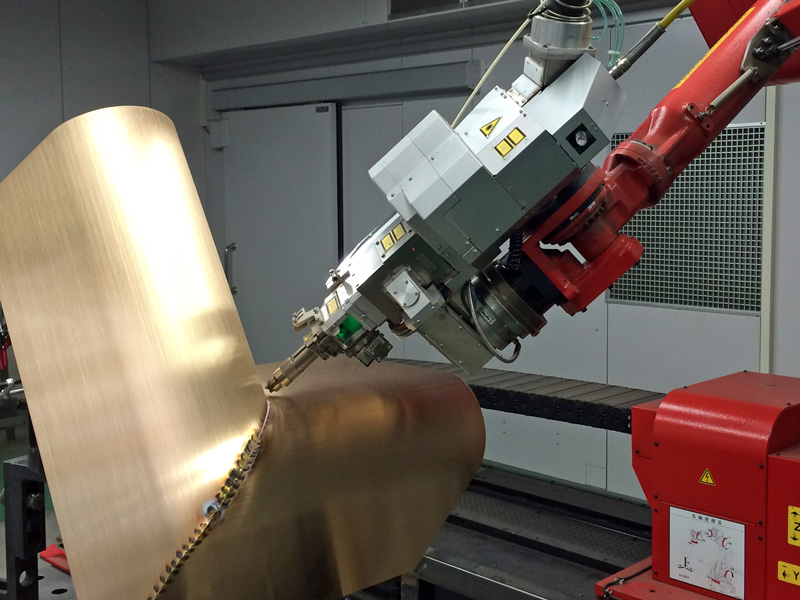
TIG tack welded, then laser welded three dimensionally
By combining the latest welding technology and robotics, KIKUKAWA provides high-quality welding on extra-long, over-sized and complex shaped products. These are small beaded deep welds with minimal welding distortion or discolouration. In addition to providing high-quality metal products, Kikukawa is able to conduct or welding of dissimilar metals.
| Main Features | -Cutting-edge welding technology -Welding with small affected heat zones -Able to accommodate over-sized, extra-long and complex shapes -Able to accommodate small lots of a high-variety product lines -Long distance welding -Accommodates highly reflective metals -Accommodates dissimilar metal welding |
|---|---|
| Name/Type | Multi-mode Fibre Laser Beam Welding Machine |
| Applicable Materials | Stainless Steel 0.8mm~6.0mm Aluminium 1.0mm~5.0mm Copper Alloys 1.0mm~3.0mm Steel 0.8mm~6.0mm *Able to accommodate titanium and nickel alloys. |
| Capacity | 6 axis machining 6kW high intensity beam Laser spot size range 0.45mm~2.0mm |
| Maximum Workable Size | 1200mm (W) x 7000mm (L) x 1300(H) *Please consult us on any products over this size |
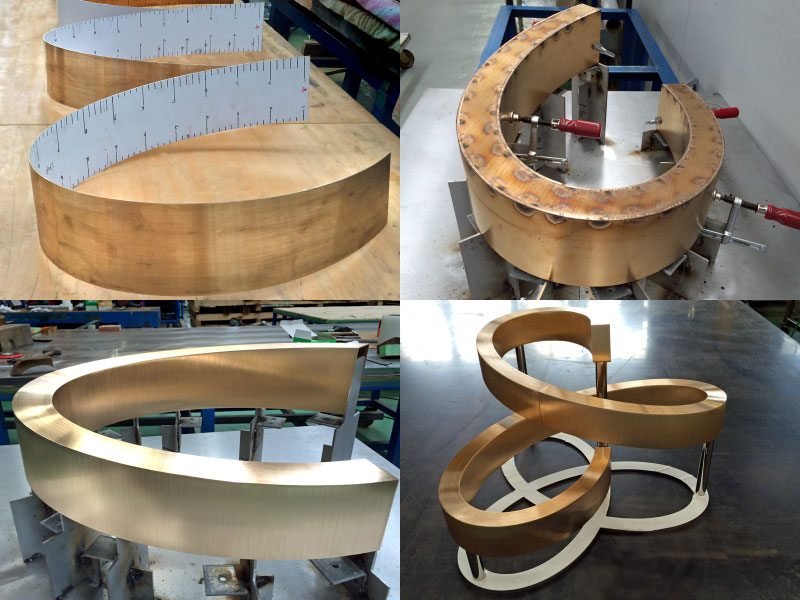
The fabrication process of the hypotrochoid ramp of Bloomberg London
■What is Fibre Laser beam Welding (FLW)?
Unlike conventional welding processes such as gas arc welding or semi-automatic welding, fibre laser welding relies on light as a source of heat. Since Einstein’s establishment of the theoretical foundations in 1917, laser welding has been a fundamental technology in various industries such as IT, fabrication, healthcare, and beauty.
Essentially, lasers are lights that are amplified through a medium – and depending on this medium, laser is categorized as solid, gas, and liquid. Typically, lasers used in fabrication are the gas-state CO2 laser, and solid-state YAG laser or fibre lasers. Each stands for the medium, CO2 (carbon dioxide) gas, YAG (Yttrium Aluminium Garnet) crystals, and fibre (optical fibres).
Amongst these various laser welding types, fibre laser welding allows for the highest power density and highest concentrated beams. The power of laser welding is said to be 3180 times that of gas arc welding.
■Advantages of Fibre Laser Welding (FLW)
Fibre laser welds are “small” and “deep”. Welding beads and heat-affected areas are minimal, and high-strength welding is achieved at high speed. Discolouration or deformation, burns from welding are minimal, thus contributing directly to the quality of the product finishes. Additionally, the quick yet deep welding translates to high strength welding joints and the removal of edge preparation process.
The robotic nature of this welding accommodates complex welding requirements such as remote welds, long welds, curved welds and spot welds. The robotic program can be combined with NC or CAD/CAMs thus making complex 3-dimensional welding from 3D-CADs (such as Solidworks) possible.
■Examples of Fibre Laser Welding
Here are a few examples of the implementation of this fibre laser welding technology within KIKUKAWA.
Bloomberg London, Hypotrochoid Interior Ramp (Bronze)
Each panel of the hypotrochoid* ramps of Bloomberg London is three-dimensionally curved. To implement the joint-less design, the largest of these panels are 2600mm (W) x 2731mm (L).
To join the walls and the cap pieces in a smooth curve, 3D-CADs like Solidworks and welding frames were essential.
For more information on bronze panels of Bloomberg London, click here
*Hypotrochoid: The roulette traced by a fixed point from a circle, rolling around another circle.
Sink Counter (Stainless Steel)
The welding length of this counter was 4000mm, a counter fabricated by laser welding stainless flat bars and metal sheets. The minimally deformed welding acts as water sealant, providing a high-quality finish for the counter.
Decorative Hardware (Stainless Steel)
- 1. Decorative Gate
The metal decorations on the gate of a school feature curvatures inspired by foliage scrolls. Production of these decorative metals required fibre laser welding to weld precisely in line with the curvatures, to enable a finish that enhances the beauty of stainless steel.
For more information on the decorative gate of American School in Japan, click here
- 2. Ellipsoid
A decorative stainless steel ellipsoid installed outside an ossuary was fabricated, welded and finished in the factory and brought on-site as one 4776mm (W) x 3300mm (H) piece. This was actualised by welding several stainless steel panels together; however, the complex shape and the specified finish required a high-quality welding.
Frames and Panels (Stainless Steel)
The kaleidoscopic entrance of Tokyu Plaza, Omotesando Harajuku required high-quality mirror polished stainless steel. To fabricate these with minimal deflection, Kikukawa used fibre laser welding to attach the backing frames to the panels.
For more information on Tokyu Plaza, Omotesando Harajuku, click here
Mirror Polished Panels (Stainless Steel)
The mirror polish finish is a demanding finish as the quality of the material, finish and the fabricated panel is visible from the reflection.
A particular design required L shaped stainless steel panels to be installed in a circular lobby. As the round shape makes fabrication with bending impossible, welding curved stainless steel panels into an L shape was necessary. However, using conventional welding techniques would not have been able to achieve the high quality as required.
Gratings (Stainless Steel)
Previously, Kikukawa fabricated gratings by TIG welding stainless steel flat bars. This welding requires highly experienced craftsmanship and time. Upon consideration of other methodologies, Kikukawa was able to solidify pulse welds which minimized welding burns.
Mock-up of Pedestrian Bridges (Stainless Steel)
One millimeter thick stainless steel panels were laser cut and laser welded to actualise a beautiful mock-up of a pedestrian bridge that effectively takes in the light.
■KIKUKAWA’s Fibre Laser Welding
- 1. Applicable materials and sizes
Kikukawa is able to laser weld stainless steel (0.8mm~6.0mm), aluminium alloy (1.0mm~5.0mm), bronze alloys (1.0mm~3.0mm), and steel (0.8mm~6.0mm). Titanium and nickel alloys are also applicable upon request.
Workable sizes are up to 1200mm (W) x 7000mm (L) x 1300mm (H), however, limitations may differ based on product shapes.
- 2. Laser welding know-how
Since its installation 8 years ago, Kikukawa has been welding various materials and products. This deepened our understanding of laser welding and solidified the know-how, whilst also allowing us to explore its limitations.
This includes the invention of new welding jigs and its methodology or the compilation of welding deformation experiments internally.
For instance, deformation of welding stainless steel can be limited to 1/10 in comparison to TIG welding according to an internal study.
Furthermore, the minimization of welding discolouration means that a finish like sulfurization that is highly dependent on the material’s colour can be applied to complex and larger products.
- 3. Finding solutions
In addition to fibre laser welding, Kikukawa holds various machinery for bending and other metal-crafting. By combining this with Kikukawa’s craftsmanship, we are able to select the most suitable and efficient fabrication methodology.
■KIKUKAWA’s and Fibre Laser Welding
Previously, it was considered best to weld non-steel materials by TIG welding. However, ensuring the necessary welding strength meant that the products needed to be processed to remove the welding burns and deformation. Thus high-quality welding is difficult, costly and time-consuming. Additionally, it is not an overstatement to say that the success of the realization of double curved panels is highly dependent on welding with minimal deformation.
In order to meet the increase in demand for double curved products and high-quality welding, Kikukawa’s research lead to the addition of fibre laser welding machine in 2010, a rare decision within the architectural metal-crafting community.
Amongst the various fibre laser welding machinery, Kikukawa uses the multi-mode* fibre laser. The irradiation width of multi-mode is one of the largest amongst the fibre laser welding machines and is therefore well suited for fabrications of large-scale architectural products. The multi-mode also allows welding of bronze alloys, a common material dealt by Kikukawa.
*Multi-mode: According to the power and the laser’s shape, lasers can be categorized as single-mode and multi-mode. The irradiation of single mode lasers is roughly 0.1mm, while multi-mode can be expanded to 0.45mm ~ 2.0mm.
■Please consult us
At Kikukawa, various materials, shapes, and sizes are metal-crafted through the use of various machines; from cutting, bending to welding. By combining other metal-crafting technology and developing new technologies, Kikukawa has answered needs that could not have been met with previous welding methodologies. From consultation to fabrication feasibility, please do not hesitate to contact us.
For more information on metalworking capabilities, click here
https://www.kikukawa.com/en/order-metal/

The fabrication process of the hypotrochoid ramp of Bloomberg London
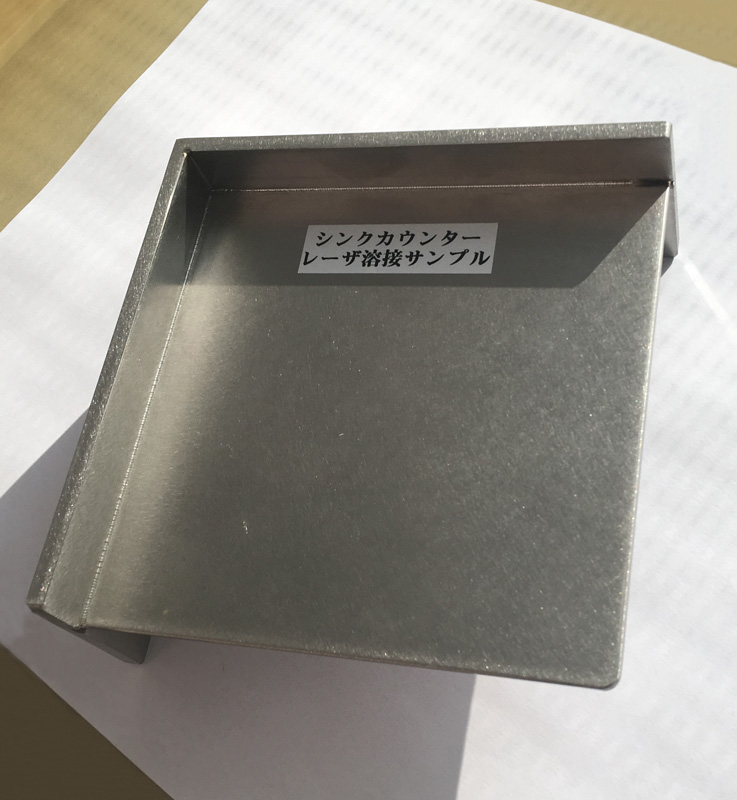
Stainless steel counter, fabricated by welding a flat bar and a metal sheet. The welding also functions as a water sealant
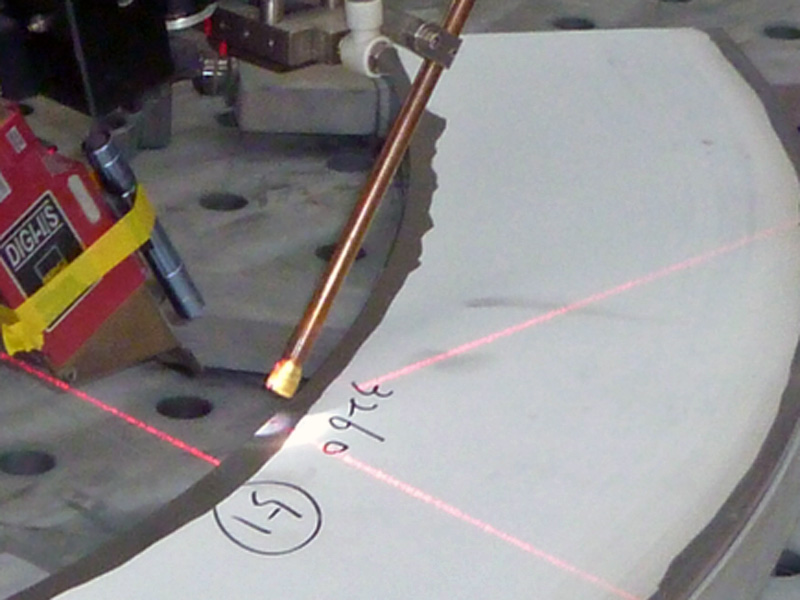
Fabricating the R curved decorations for the gate of ASIJ
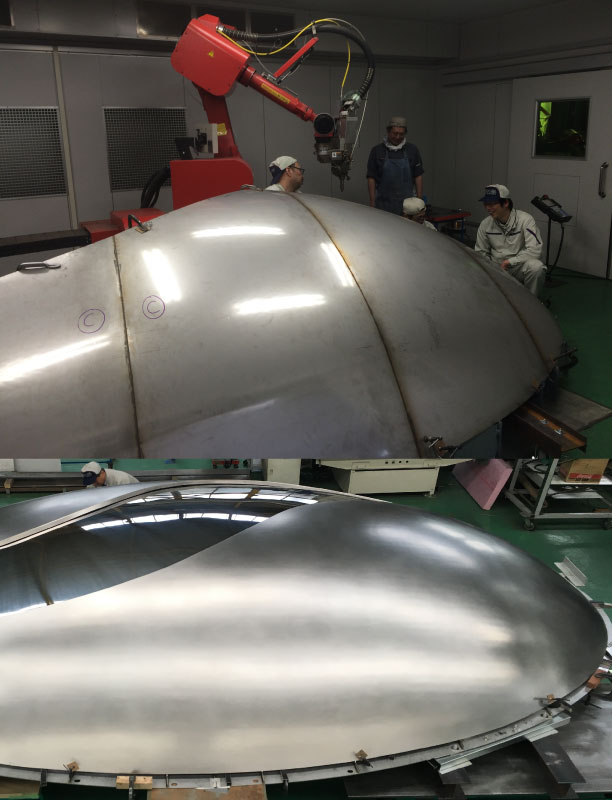
Before and after finishing a laser welded three dimensional panel


